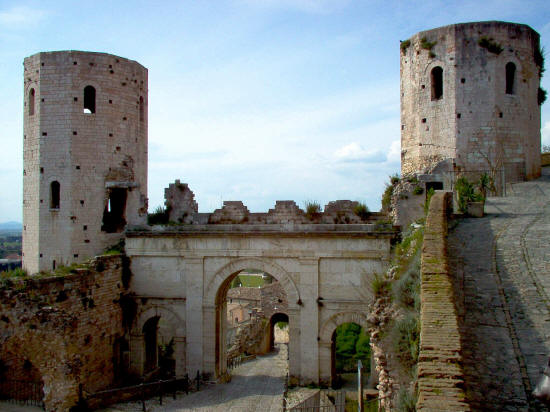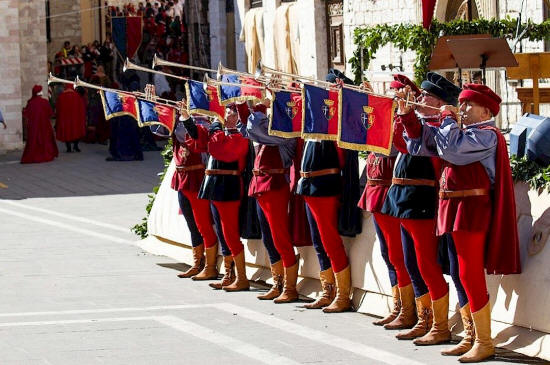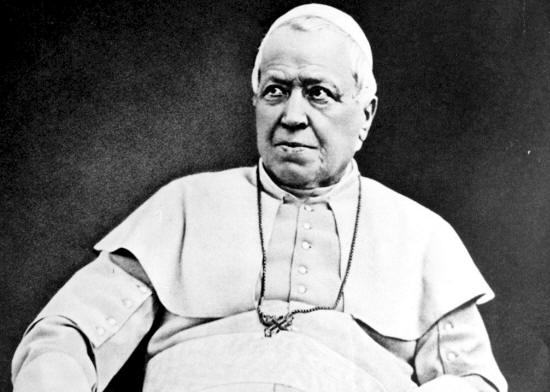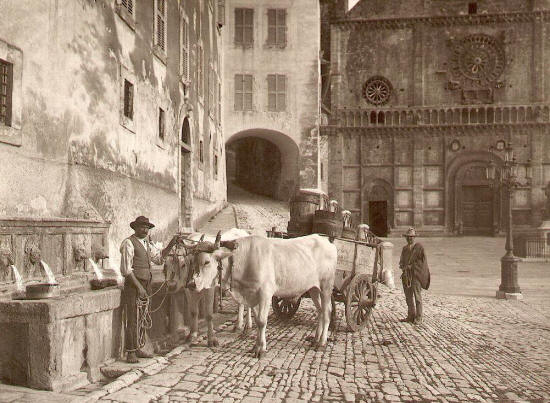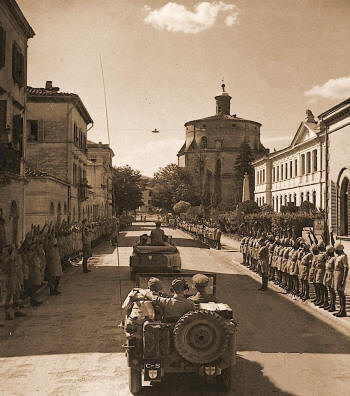Ancient UmbriaUmbria takes it name from the Umbri, a pre-Roman, Italic tribe who were absorbed by the expansion of the Romans. Gubbio was the captial of the Umbri and it is at Gubbio that one may view the longest and most important document of any of the Osco-Umbrian linguistic family, the Iguvine Tablets. The language of the Umbri was Umbrian, an Italic language and part of the same linguistic family as Latin and Oscan. The Etruscans were the chief enemies of the Umbri. The Etruscan invasion extended from the western seaboard towards the north and east from about 700 to 500 BC. They eventually drove the Umbrians towards the Apennine highlands and captured 300 Umbrian towns. Nevertheless, the Umbrian population does not seem to have been eradicated in the conquered districts. The border between Etruria and Umbria was the Tiber river, as established by the ancient name of Todi, Tular ("border"). After the downfall of the Etruscans, the Umbrians aided the Samnites in their opposition to the Romans (308 BC) but communications with Samnium were impeded by the Roman fortress of Narnia (founded 298 BC - modern Narni). The Romans defeated the Samnites and their Gallic allies in the battle of Sentinum (295 BC). The Umbrians and Etruscans had to return to defend their own territories against simultaneous Roman attacks, leaving the Samnites without their help in the battle of Sentinum.
The Roman victory at Sentinum initiated a period of integration under the Roman rulers, who established some colonies, such as Spoletium (modern Spoleto), and built the via Flaminia (220 BC). The via Flaminia became the main contributor to Roman development in Umbria. During Hannibal's invasion during the second Punic war, the Romans were famously defeated at Lake Trasimeno in Umbria, but the local people did not aid the invader. During the Roman civil war between Mark Antony and Octavian in 40 BC, the city of Perugia supported Antony and was almost completely destroyed by Octavian. In the time of Pliny the Elder, 49 independent communities still existed in Umbria, and the abundance of inscriptions and the high proportion of recruits in the Roman army indicate a considerable population. Under Augustus, Umbria became Regio VI of Roman Italy. Modern Umbria is geographically different from Roman Umbria. The latter extended through most of what is now the northern Marche to Ravenna, but excluded the west bank of the Tiber, which belonged to Etruria. Thus Perugia was an Etruscan city and the area around Norcia belonged to the Sabines. After the collapse of the Roman Empire, the Ostrogoths and Byzantines struggled for supremacy over Umbria. Mediaeval UmbriaAfter the Ostrogoths, the Lombards founded the Duchy of Spoleto, covering much of today's southern Umbria, but the Byzantines retained a corridor along the Via Flaminia linking Rome with the Exarchate of Ravenna and the Pentapolis. The Lombard king also controlled the northern part of the region ruled directly by Pavia. When Charlemagne conquered most of the Lombard kingdoms, some Umbrian territories were given to the Pope, who established temporal power over them. Some cities acquired a form of autonomy in the form of a comune - a semi-autonomous municipality. These cities were frequently at war with one another, often in a context of more general conflicts, either between the Papacy and the Holy Roman Empire or between the Guelphs and Ghibellines. In the early 14 C, the signorie (Ghibellines) arose and the most important of them were those of the Vitelli in Città di Castello, of the Baglioni in Perugia and of the Trinci in Foligno, but the two latter were subsumed by the middle of the same century into the Papal States by Cardinal Albornoz, who in this way prepared the return of the pope from Avignon to Rome. Città di Castello was subsumed later into the Papal States by Cesare Borgia. During 15 C, the Renaissance spread in the northern part of the region. It was in this period that humanists started to use the ancient denomination of "Umbria" to name the area once again, which until then has been named "Ducato", after the Duchy of Spoleto in the southern part of it. The supremacy of the Pope over Umbria was reinforced in 16 C through the erection of a fortress in Perugia by Pope Paul III, named after him Rocca Paolina. The Papacy ruled the region uncontested until the end of the 18 C. Modern UmbriaThe Revolution of 1831A number of young Umbrians who had fought for Napoleon and suffered exile after his fall coalesced in ca. 1830 to form the Umbrian branch of “Young Italy”. Prominent among them were Francesco Guardabassi of Perugia and Louis Pianciani of Spoleto. The patriots converged on Bologna in February 1831 and marched on Rome. However, the insurrection failed and many of the participants were driven into exile. Pope Pius IX (1846-78)Giovanni Maria Mastai-Ferretti, Archbishop of Spoleto (1827-32) and subsequently bishop of Imola, became a cardinal on 1840 and was elected as Pope Pius IX in 1846. He was popular because of his sympathy for reform: he appointed Cardinal Tommaso Pasquale Gizzi, a leading liberal, as his secretary of state, relaxed censorship and announced an amnesty for political prisoners. Thus he was affectionately known as “Pio Nono”. Cardinal Gizzi resigned in 1847, when he went so far as to permit the towns and cities of the Papal States to form civic guards, which involved the arming some of their citizens. In January 1848, revolution broke out in Naples. In
order to reduce tension in Rome, Pius IX formed a liberal ministry
under Cardinal Giacomo Antonelli with a new constitution for the
Papal States. Revolution against the Habsburgs broke out soon after
in Vienna, prompting Metternich to flee and unleashing similar
uprisings in Milan and Venice under King Charles Albert of Piedmont
and Sardinia. Pius IX was equivocal in his support and this led to
revolution in Rome in November 1848. The unpopular Minister of the
Interior, Pellegrino Rossi, was murdered, and people took to the
streets demanding war against the Habsburgs. Pius IX fled south to
Gaeta.
World War IIThe Second World War destroyed the industrial development that Umbria had finally achieved at the beginning of the 20 C when Umbria was regarded as a centre of industrial development. It was the era of fascism and Umbria was a focal point for industry. However, the devastation caused during World War II destroyed any previous growth. Terni and Foligno, in particular, were targeted, with steelworks pulled apart by German troops and bombed. After the destruction of WWII, the area received some restoration and hydroelectric plants were set up along the Tiber and Nero rivers but Umbria has more or less remained principally an agricultural Region. |
